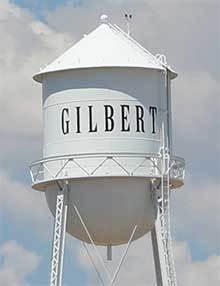Gilbert, Arizona's Water Quality
October 02, 2023

In August 2017, the City of Gilbert notified residents that there was a non-emergency issue with Gilbert’s drinking water.
The basic details were that, although the water was safe to drink, testing revealed that Total Trihalomethanes (TTHMs) were above the acceptable limit at one of the city’s six testing sites. The issue occurred due to a mechanical failure at one of the reservoirs feeding the North Water Treatment Plant.
Gilbert communicated the issue clearly and quickly and repaired the mechanical failure as soon as they became aware of the problem – yet another reason to love the City of Gilbert. Still, it started my mind wondering: How does Gilbert ensure its citizens have clean drinking water?
Who Is Responsible for Gilbert’s Water Quality?
The entity overseeing Gilbert’s drinking water is the Town of Gilbert Water Quality. They perform daily water quality tests (up to 100), ensuring your drinking water meets state and federal standards.
Every three years, Gilbert also tests the water from 50 homes, looking specifically for lead and copper, where maximum allowable levels are 15 ppb (parts per billion). The most recent test year was 2016 when 90 percent of homes tested came in at 3.6 ppb. The highest level found was 10. Zero homes came in at the 15 ppb limit.
Where Does Gilbert Drinking Water Come From?
Gilbert has three main sources for its drinking water: the Salt River Project (SRP), the Central Arizona Project (CAP), and groundwater.
SRP taps Arizona watershed (snow and rain runoff) to deliver water to the valley. Its delivery methods include 131 miles of canals, over 1,000 miles of ditches and laterals, and dams and reservoirs at East Clear Creek and the Salt and Verde rivers.
Water from SRP feeds to North Water Treatment Plant (NWTP), which employs the coagulation, flocculation, sedimentation, and filtration method described in the article linked above. NWTP has a capacity of 45 million gallons per day (MGD) and a reservoir of 16 million gallons (MG).
CAP water comes from Colorado River watershed, where it enters the Santan Vista Water Treatment Plant (SVWTP) via 14 miles of iron pipeline. SVWTP employs ballasted flocculation to treat water. Currently, the plant provides 12 MGD to Gilbert residents and businesses. Capacity is expected to double upon completion of the treatment plant’s expansion in spring 2018. SVWTP also has a 6 MG reservoir.
Finally, 17 wells throughout Gilbert provide 44 MGD of groundwater, used whenever demand is high or canals are closed for maintenance. All together, Gilbert has around 101 MGD with 45 MG in reservoirs, more than enough to meet the town’s water needs.
What Is the Difference Between Acute and Chronic Contaminants?
Going back to the notice Gilbert Water Quality sent residents the summer of 2017, the question many people ask is, why was the water deemed safe to drink, even though it showed high levels for TTHM? The answer? Because TTHM is a chronic contaminant.

We also covered this in a previous post about Arizona’s drinking water, but it needs to be explained here so you understand why Gilbert’s drinking water was still safe despite TTHM levels above the recommended amount.
Acute contaminants are those that, if they make their way into your drinking water, you experience the effects within hours or days. Chronic contaminants, on the other hand, are those that require prolonged exposure – measured by the EPA as drinking 2 liters of water per day for 70 years – before feeling any ill effects. In other words, drinking water with slightly high TTHM levels only becomes dangerous if you do it for decades, not days.
Trihalomethanes form as a byproduct of disinfecting drinking water with chlorine, a necessary step in the water treatment process. It’s a simple chemical reaction that occurs when chlorine encounters organic matter, such as algae and leaves, in a water source.
Disinfection is the final stage in most water treatment plants, and it’s a necessary one. The chlorine kills a wide variety of harmful items, including parasites, bacteria, and viruses, before the water makes its way to your home or business.
Keeping Your Water Safe and Delicious

Even though Gilbert’s drinking water meets all state and federal guidelines for safety, many people find it less than delicious straight from the tap. This is due, in part, to the fact that Arizona water is unusually hard (meaning it has high levels of calcium and magnesium).
Water with more than 3.5 grains per gallon of calcium and magnesium bicarbonates is considered hard water. In the Phoenix-Metro area, Gilbert has the lowest hard water levels, coming in around 9 grains per gallon. The Valley’s hardest water is found in Glendale, at 17.5 grains, with Mesa a close second at 17.
If you’re concerned about hard water or the safety of your water, Patrick Riley | Isley’s offers a variety of water treatment options, including whole home filtration, water softeners, and reverse osmosis units. Call us today to learn more.
Get 10% off (Up to $150)

Ty Lindsay is the Director of Field Operations at Patrick Riley | Isley’s and a 15-year veteran of the plumbing and HVAC trades. In 2010, Ty earned his Journeyman’s plumbing license. He became a Master Plumber five years later and earned his Journeyman HVAC technician’s license that same year. Ty’s breadth of knowledge in plumbing and HVAC includes both residential and commercial work. He’s been a loyal member of the Patrick Riley | Isley’s team since 2016.
- Posted in:
- Tips
